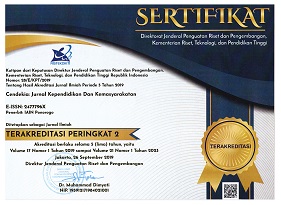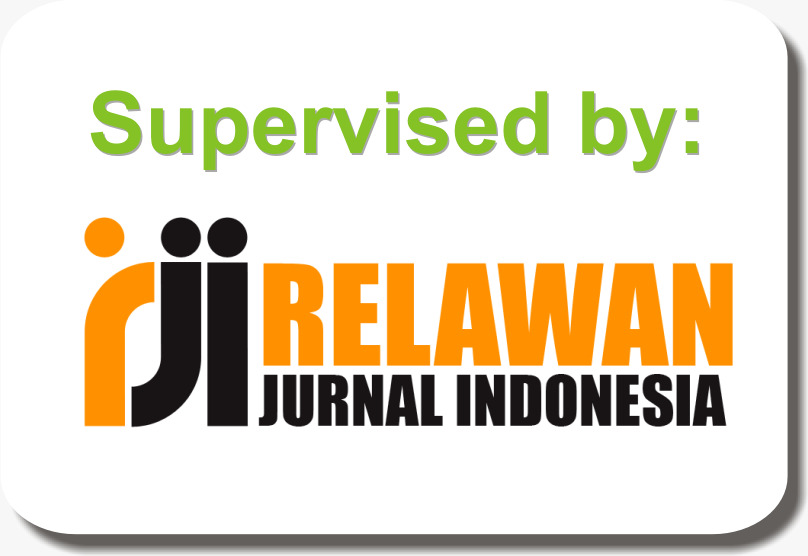ANALYSIS OF EXISTENTIAL PSYCHOLOGY TOWARDS THE MAIN CHARACTER OF NOVEL PINTU BY FIRA BASUKI
DOI:
https://doi.org/10.21154/cendekia.v11i2.280Abstract
Abstrak: Tujuan penelitian ini adalah untuk menganalisa masalah psikologis yang dihadapi oleh tokoh utama dalam novel Pintu karya Fira Basuki dari sudut pandang psikologi eksistensial. Desain deskriptif kualitatif dengan menggunakan analisis isi diterapkan dalam penelitian ini. Hasil penelitian menunjukkan bahwa masalah psikologis yang dihadapi oleh tokoh utama dalam novel tersebut dapat dikelompokkan ke dalam tema-tema eksistensialisme seperti (1) kebersamaan, cinta, dan konflik, (2) kesepian, keterasingan, dan kecemasan, dan (3) kematian. Terlihat bahwa tokoh utama Bowo belum memiliki mental dewasa. Hal ini ditunjukkan dalam peristiwa yang menekan kehidupan batinnya. Jiwanya belum begitu kuat. Konsekwensinya, banyak hal menyentuh hidupnya dalam hal eksistensial. Hubungan cinta antara dia dan orang-orang di sekitarnya telah dibangun, tetapi tidak otentik. Mereka semuanya berposisi sebagai subyek. Akibatnya, konflik yang terjadi dalam hidupnya sangat kuat. Bowo sebagai individu juga merasakan kekosongan dan kesepian yang begitu kuat. Dalam menyikapi kondisi tersebut, yang sebenarnya diciptakan oleh dirinya sendiri, ia menerapkan konsep yang tidak otentik. Jadi, hal tersebut telah mengantarkannya ke dalam keterasingan. Selanjutnya, Bowo menghadapi masalah kematian dari kerabat dekatnya, tapi dia masihsepenuhnya melanjutkan perjuangan hidupnya.
”بابلا “ ةياورلا ÙÙŠ ةياورلا لطب اههجاوي تيلا ةيجولوكيسلا لئاسلما Ù„ÙŠÙ„ØªØ Ù„Ù‰Ø¥ Ø«Øبلا اذه Ùدهي :صخلم
.نومضلما ليلØتب ÙŠÙصولا Ø«Øبلا ميمصت Ø«Øبلا اذه عبتا .يدوجولا يجولوكيسلا بنالجا نم يكوساب اير٠اهتبتك
ةيدوجو تاعوضوم لىإ اهÙينصت نكيم ةياورلا لطب اههجاوي تيلا ةيجولوكيسلا لئاسلما نأ ىلع Ø«Øبلا جئاتن تلد
ةياورلا هذه ÙÙŠ ترهظ .تولما )3 ،لجلخاو ،لازتعلااو ،وللخاو نوكسلا )2 ،عازنلاو ،بلØاو ،ةيعلما )1: لثم
تناكو ،ةيØورلا Ù‡ØªØ§ÙŠØ Ø¯Ø¯Ù‡ØªÙˆ بيصت تيلا عئاقولا نم هذه ترهظ .غلاب لجر ةيصخش هل نكت لم ”وووب“ نأ
Ù‡Ù„ÙˆØ ÙŠÙ†Ø·ÙŠÙ„Ù…Øا ينبو هنيب بلØا قلعت دقو .ةيدوجولا ÙÙŠ Ù‡ØªØ§ÙŠØ Ø³ØªÙ… روملأا نم ايرثك نأ Ø«ÙŠØ Ø©Ùيعض هسÙÙ†
رعش يناسنلإا درÙلاكو . Ù‘ يوق Ù‡ØªØ§ÙŠØ ÙÙŠ يلخادلا عازنلا نإ٠اذل ،نولعا٠اعيجم ءلاؤه Øبصأو .يعيبط يرغ هنكل
موهÙلما وه قبط ”“ ةلالØا هذله ئشنلما هسÙÙ† وه ةقيقلØا Ùيو ”“ لئاسلما هذه ةلباقم Ùيو .Ù‘ وللخاو لازتعلااب ”وووب“
رداق هنكل ،هئابرقأ ةاÙÙˆ ةاسأم ”وووب“ هجاوي كلذ دعبو .وللخاو لازتعلااب روعشلا لىإ Ù‡Ù„Ù…ÙŠØ Ø§Ø°Ù‡Ùˆ .يلصلأا يرغ
.Ù‡ØªØ§ÙŠØ Ø®ÙŠØ±Ø§Øª ةلصاوم ىلع
Keywords: Psikologi eksistensial, tokoh utama, karya sastra.
Downloads
Published
Issue
Section
License
Copyright & License
Please find the rights and licenses in Cendekia: Jurnal Kependidikan dan Kemasyarakatan. By submitting the article/manuscript, the author(s) agree with this policy. No specific document sign-off is required.
1. License
The non-commercial use of the article will be governed by the Creative Commons Attribution license as currently displayed on the Creative Commons Attribution-NonCommercial 4.0 International License.
2. Author(s)' Warranties
The author warrants that the article is original, written by the stated author(s), has not been published before, contains no unlawful statements, does not infringe the rights of others, is subject to copyright that is vested exclusively in the author and free of any third party rights, and that any necessary written permissions to quote from other sources have been obtained by the author(s).
3. User/Public Rights
The spirit of Cendekia: Jurnal Kependidikan dan Kemasyarakatan is to disseminate articles published as free as possible. Under the Creative Commons license, Cendekia: Jurnal Kependidikan dan Kemasyarakatan permits users to copy, distribute, display, and perform the work for non-commercial purposes. Users will also need to attribute authors and Cendekia: Jurnal Kependidikan dan Kemasyarakatan on distributing works in the journal and other media of publications. Unless otherwise stated, the authors are public entities as soon as their articles got published.
4. Rights of Authors
Authors retain all their rights to the published works, such as (but not limited to) the following rights;
- Copyright and other proprietary rights relating to the article, such as patent rights,
- The right to use the substance of the article in own future works, including lectures and books,
- The right to reproduce the article for own purposes,
- The right to self-archive the article,
- The right to enter into separate, additional contractual arrangements for the non-exclusive distribution of the article's published version (e.g., post it to an institutional repository or publish it in a book), with an acknowledgment of its initial publication in this journal (Cendekia: Jurnal Kependidikan dan Kemasyarakatan).
5. Co-Authorship
If the article was jointly prepared by more than one author, any author submitting the manuscript warrants that he/she has been authorized by all co-authors to be agreed on this copyright and license notice (agreement) on their behalf and agrees to inform his/her co-authors of the terms of this policy. Cendekia: Jurnal Kependidikan dan Kemasyarakatan will not be held liable for anything arising due to the author(s) internal dispute. Cendekia: Jurnal Kependidikan dan Kemasyarakatan will only communicate with the corresponding author.
6. Royalties
Being an open accessed journal and disseminating articles for free under the Creative Commons license term mentioned, the author(s) are aware that Cendekia: Jurnal Kependidikan dan Kemasyarakatan entitles the author(s) to no royalties or other fees.
7. Miscellaneous
Cendekia: Jurnal Kependidikan dan Kemasyarakatan will publish the article (or have it published) in the journal if the article's editorial process is completed. The editors of Cendekia: Jurnal Kependidikan dan Kemasyarakatan may modify the paper to a style of punctuation, spelling, capitalization, referencing, and usage that deems appropriate. The author acknowledges that the article may be published so that it will be publicly accessible, and such access will be free of charge for the readers, as mentioned in point 3.

















